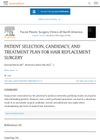 21 citations,
July 2020 in “Stem Cell Research & Therapy”
21 citations,
July 2020 in “Stem Cell Research & Therapy” Fat stem cells from diabetic mice can still help heal wounds.
 18 citations,
July 2020 in “Basic and Clinical Andrology”
18 citations,
July 2020 in “Basic and Clinical Andrology” Wait 3 months after COVID-19 before trying assisted reproduction and further research is needed on COVID-19's effects on male hormones and fertility.
 2 citations,
June 2020 in “BMC Health Services Research”
2 citations,
June 2020 in “BMC Health Services Research” Health warnings and public health actions led to a significant drop in flutamide prescriptions for women, but off-label use still continues.
 19 citations,
January 2012 in “Dermato-endocrinology”
19 citations,
January 2012 in “Dermato-endocrinology” Moderately high prolactin levels do not cause hair loss in women.
 4 citations,
March 2020 in “BMC Research Notes”
4 citations,
March 2020 in “BMC Research Notes” Skin tags in obese individuals may indicate higher cardiovascular risk.
3 citations,
July 1992 in “Clinics in Dermatology” Vitamin D helps regulate calcium levels in the body.
8 citations,
June 1982 in “Journal of adolescent health care” Teenage girls with Lupus often struggle with the disease's impact on their looks, which may lead them to change their medication without a doctor's advice.
 November 2012 in “South African Family Practice”
November 2012 in “South African Family Practice” The article concludes that early treatment of alopecia is crucial to prevent permanent hair loss.

30% supramolecular salicylic acid is safe and effective for treating mild to moderate facial acne.
 29 citations,
March 2020 in “Stem Cell Research & Therapy”
29 citations,
March 2020 in “Stem Cell Research & Therapy” Fat stem cells from diabetic mice can help heal skin wounds in other diabetic mice.
2 citations,
January 2000 in “Elsevier eBooks”  May 2023 in “Elsevier eBooks”
May 2023 in “Elsevier eBooks” Stem cell-based therapies show promise for treating various medical conditions.
 February 1996 in “International Journal of Dermatology”
February 1996 in “International Journal of Dermatology” The Seoul International Dermatology Symposium was a successful event that highlighted new dermatology treatments and fostered international relations.
 May 2023 in “Elsevier eBooks”
May 2023 in “Elsevier eBooks” The document's conclusion cannot be provided because the document is not readable or understandable.
26 citations,
January 1964 in “Experimental Cell Research” 34 citations,
July 1958 in “Biochimica et Biophysica Acta” November 2024 in “Actas Dermo-Sifiliográficas” September 1998 in “Journal of the European Academy of Dermatology and Venereology”  November 2021 in “International Journal of Trichology”
November 2021 in “International Journal of Trichology” The study found the causes and patterns of hair loss in children from South India.
4 citations,
September 1944 in “The American Journal of the Medical Sciences”  November 1999 in “Facial Plastic Surgery Clinics of North America”
November 1999 in “Facial Plastic Surgery Clinics of North America” Choose the right patients and plan carefully for successful hair replacement surgery.
254 citations,
January 2007 in “Chemical Society Reviews” Hair is a complex protein fiber with unique properties useful for developing hair products.
8 citations,
June 1981 in “Clinica Chimica Acta” 34 citations,
October 1975 in “Biochimica et Biophysica Acta (BBA) - Nucleic Acids and Protein Synthesis” March 2003 in “Clinics in Dermatology” 138 citations,
November 1977 in “Biochimica et Biophysica Acta (BBA) - Proteins and Proteomics”  20 citations,
September 2020 in “Journal of Translational Medicine”
20 citations,
September 2020 in “Journal of Translational Medicine” Mesenchymal stromal cells may help treat severe COVID-19, but more research is needed to confirm their effectiveness.
 October 2023 in “Elsevier eBooks”
October 2023 in “Elsevier eBooks” Hair transplantation is a procedure to move hair to bald areas.
 June 2021 in “Elsevier eBooks”
June 2021 in “Elsevier eBooks” The document's conclusion cannot be summarized because it is not readable or understandable.
















